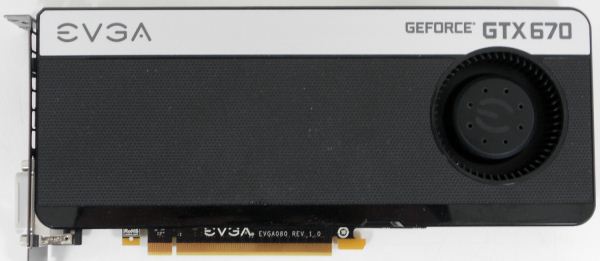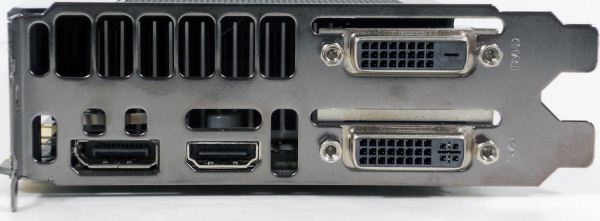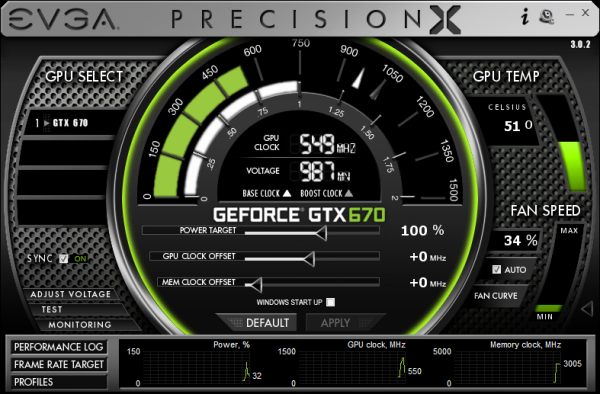NVIDIA GeForce GTX 670 Review Feat. EVGA: Bringing GK104 Down To $400
by Ryan Smith on May 10, 2012 9:00 AM ESTMeet The EVGA GeForce GTX 670 Superclocked
Our second card of the day is EVGA’s GeForce GTX 670 Superclocked, which in EVGA’s hierarchy is their first tier of factory overclocked cards. EVGA is binning GTX 670s and in turn promoting some of them to this tier, which means the GTX 670 Superclocked are equipped with generally better performing chips than the average reference card.
| GeForce GTX 670 Partner Card Specification Comparison | ||||
| EVGA GeForce GTX 670 Superclocked | GeForce GTX 670 (Ref) | |||
| CUDA Cores | 1344 | 1344 | ||
| Texture Units | 112 | 112 | ||
| ROPs | 32 | 32 | ||
| Base Clock | 967MHz | 915MHz | ||
| Boost Clock | 1046MHz | 980MHz | ||
| Memory Clock | 6210MHz | 6008MHz | ||
| Memory Bus Width | 256-bit | 256-bit | ||
| Frame Buffer | 2GB | 2GB | ||
| TDP | 170W | 170W | ||
| Manufacturing Process | TSMC 28nm | TSMC 28nm | ||
| Width | Double Slot | Double Slot | ||
| Length | 9.5" | 9.5" | ||
| Warranty | 3 Years | N/A | ||
| Price Point | $419 | $399 | ||
For the GTX 670 SC, EVGA has given both the core clock and memory clock a moderate boost. The core clock has been increased by 52MHz (6%) to 967MHz base and 66MHz (7%) boost to 1046MHz. Meanwhile the memory clock has been increased by 202MHz (3%) to 6210MHz.
Other than the clockspeed changes, the GTX 670 SC is an almost-reference card utilizing a reference PCB with a slightly modified cooler. EVGA is fabricating their own shroud, but they’ve copied NVIDIA’s reference shroud down to almost the last detail. The only functional difference is that the diameter of the fan intake is about 5mm less, otherwise the only difference is that EVGA has detailed it differently than NVIDIA and used some rounded corners in place of square corners.
The only other change you’ll notice is that EVGA is using their own high flow bracket in place of NVIDIA’s bracket. The high flow bracket cuts away as much metal as possible, maximizing the area of the vents. Though based on our power and temperature readings, this doesn’t seem to have notably impacted the GTX 670 SC.
While we’re on the matter of customized cards and factory overclocks, it’s worth reiterating NVIDIA’s position on factory overclocked cards. Reference and semi-custom cards (that is, cards using the reference PCB) must adhere to NVIDIA’s power target limits. For GTX 670 this is a 141W power target, with a maximum power target of 122% (170W). Fully custom cards with better power delivery circuitry can go higher, but not semi-custom cards. As a result the flexibility in building semi-custom cards comes down to binning. EVGA can bin better chips and use them in cards such as the Superclocked – such as our sample which can go 17 boost bins over the base clock versus 13 bins for our reference GTX 670 – but at the end of the day for stock performance they’re at the mercy of what can be accomplished within 141W/170W.
In any case, as the card is otherwise a reference GTX 670 EVGA is relying on the combination of their factory overclock, their toolset, and their strong reputation for support to carry the card. EVGA has priced the card at $419, $20 over the GTX 670 MSRP, in-line with other factory overclocked cards.
On the subject of pricing and warranties, since this is the first EVGA card we’ve reviewed since April 1st, this is a good time to go over the recent warranty changes EVGA has made.
Starting April 1st, EVGA has implemented what they’re calling their new Global Warranty Policy. Starting July 1st, 2011 (the policy is being backdated), all new EVGA cards ship with at least a 3 year warranty. And for the GTX 600 series specifically, so far EVGA has only offered models with a 3 year warranty in North America, which simplifies their product lineup.
To complement the 3 year warranty and replace the lack of longer term warranties, EVGA is now directly selling 2 and 7 year warranty extensions, for a total of 5 and 10 years respectively. So instead of buying a card with a 3 year warranty or a longer warranty, you’ll simply buy the 3 year card and then buy a warranty extension to go with it. However the extended warranty requires that the card be registered and the warranty purchased within 30 days.
The second change is that the base 3 year warranty no longer requires product registration. EVGA has other ways to entice buyers into registering, but they’ll now honor all applicable cards for 3 years regardless of the registration status. At the same time the base 3 year warranty is now a per-product warranty (e.g. a transferable warranty) rather than per-user warranty, so the base warranty will transfer to 2nd hand buyers. The extended warranties however will not.
The third change is how EVGA is actually going to handle the warranty process. First and foremost, EVGA is now allowing cards to be sent to the nearest EVGA RMA office rather than the office for the region the card was purchased from. For example a buyer moving from Europe to North America can send the card to EVGA’s North American offices rather than sending it overseas.
Finally, EVGA is now doing free cross shipping, alongside their existing Advanced RMA program. EVGA will now cross-ship replacement cards for free to buyers. The buyer meanwhile is responsible for paying to ship the faulty card back and putting up collateral on the new card until EVGA receives the old card.
There’s also one quick change to the step-up program that will impact some customers. With the move to purchasing extended warranties, the step-up program is only available to customers who either purchase an extended warranty or purchase an older generation card that comes with a lifetime warranty. Step-up is not available to cards with only the base 3 year warranty.
Moving on, along with EVGA’s new warranty EVGA is bundling the latest version of their GPU utilities, Precision X and OC Scanner X.
Precision X, as we touched upon quickly in our GTX 680 review, is the latest iteration of EVGA’s Precision overclocking & monitoring utility. It’s still based on RivaTuner and along with adding support for the GTX 600 series features (power targets, framerate caps, etc), it also introduces a new UI. Functionality wise it’s still at the top of the pack along with the similarly RivaTuner powered MSI Afterburner. Personally I’m not a fan of the new UI – circular UIs and sliders aren’t particularly easy to read – but it gets the job done.
OC Scanner X has also received a facelift and functionality upgrade of its own. Along with its basic FurMark-ish stress testing and error checking, it now also offers a basic CPU stress test and GPU benchmark.



















414 Comments
View All Comments
Morg. - Thursday, May 10, 2012 - link
You know, anyone can pick a set of games and draw a seemingly mathematical conclusion and still be dead wrong at the end. Point being, If you like buying good hardware for cheap, don't take tainted titles into account, it'll only lead to more vendor sponsoring of games, more expensive hardware, more crap for nothing.Frostbite 2 was developed WITH nVidia, it artificially favors their tech and that's not in our interest is it ?
That HWC and others follow the same trend makes no diff bro, they all want your mullah ;)
theprodigalrebel - Thursday, May 10, 2012 - link
>>Frostbite 2 was developed WITH nVidia, it artificially favors their tech and that's not in our interest is it ?Incorrect. It's an AMD Gaming Evolved title.
http://blogs.amd.com/play/2011/09/01/battlefield-3...
Morg. - Friday, May 11, 2012 - link
That information is not in your link. nVidia helped develop frostbite 2 . AMD mentions eyefinity support and that's it.CeriseCogburn - Friday, May 11, 2012 - link
" AMD partnered with SEGA and Creative Assembly on Total War: Shogun 2 through the AMD Gaming Evolved program to implement DirectX® 11 features into the game. Richard Gardner, the Lead Graphics Developer for the game discusses these features and how AMD effectively supported the Shogun 2 team."http://www.youtube.com/watch?v=J0eZEdpsgjk
Now, after nVidia was whomping amd in this most difficult game of all the benchmarks here, a new, no doubt, Gaming Evolved coached and inspired patch for the game "broke the nVidia cards"...
Way to go evil amd, you said you'd never be evil but clearly scalping, proprietary openCL winzip hacked into only your corner, and GE hacking are now all part and parcel of evil amd.
It's sad time for amd fanboys.
CeriseCogburn - Friday, May 11, 2012 - link
Lepton > " Ever since 6870 launch you had strict policy of no OC cards in launch articles yet you did it again. Where's the consistency? "Would you like to go see the 7950 launch article here that has a stock, and two extra 7950 OC cards... ?
How can you amd fans be so blind and ignorant, I mean you "know about a strict policy", but when like yesterdays amd card came out with 2 screaming overclocks for a total of 3 at once amd release only, you like -- faded into oblivion, before and after ?
You are not a particle. No way, not worthy dude.
tech6 - Thursday, May 10, 2012 - link
Now that both AMD and Nvidia have competitive 28nm products, one would hope that competition will drive down the price. However, that will only happen if Nvidia can actually meet demand and deliver enough product. Here is hoping the 670 will eventually sell for $350...Spunjji - Thursday, May 10, 2012 - link
Agreed.CeriseCogburn - Friday, May 11, 2012 - link
In other words, you calim nVidia has met product demand with the 680 as it drove down amd prices - right ? You said prices will go down now only IF nVidia can meet demand, and you meant the 670 since that's the article.Since prices already went down on 7970, you clearly believe nVidia has met demand with the 680 as it drove down that amd price...
Now, the other fellow already agreed with you but one definitely has to wonder why, as it makes him appear just as clueless to your self contradicting statements.
If not thanks for claiming nVidia has met 680 demand.
(roll eyes at the tut tut blabbery again)
B-Unit1701 - Saturday, May 12, 2012 - link
Are you claiming that the 7970 isn't overpriced right now?CeriseCogburn - Saturday, May 12, 2012 - link
When I compare what nVidia offers to what amd is offering, the 7970 is an embarrassment.Drivers and features on amd's side are pathetic in comparison - problems are an order of magnitude worse - 10X, while features on amd's side are now so lesser in quantity as to be absolutely definitive in negating choosing the amd product.
Clearly I am not in favor of the amd product.
The prices of the top tiers in the $350 -$500 range are what they have been for some time. Of course I want lower prices like near everyone else, but it seems to me, ignoring my personal opinion which so many amd fanboys fail to comprehend let alone adhere to in any small degree by their very words all over these pages, I cannot claim for them that the 7970 @ $450 with 3 free games is overpriced - they want it, they all love to claim it is better, obviously it is not, given their consumer mindset, overpriced. In fact with their stances and attitude, it should be $499 or a bit more, let's say $529 or even $549 with the added 3 games.
That's far and away from my personal opinion. Since the 7970 in fact is worse than the 670, and the 670 is $399, the 7970 could remain at $449 (a single cheapest Powercolor price) with it's 3 games and I wouldn't complain, certainly neither should the amd fanboys, of which here there are many.
Separate even from that, I don't see room for the 7970 @ $349 or $329 ( where it really should be vs the 670 @ $399 )- when that means the gtx590 and the hd6990 need to spot in only slightly over that - not to mention the crunching down of the gtx580 and gtx570 below $349 - so the problem is, how does everything below these two core flagship cards fit under them, and in the case of the 6990 and 590 just over them - not to forget the 580 that this year was $499 solid as a rock...
So, no I'm not given to a price complaint right now. The 7970 @ $579.99 was a fantasy raping scalper price amd went with - and it's utter destruction so quickly, with another blow now over's it's crumbling $449($479) + 3 games is a real problem for amd.
Like I said before, I don't amd budging from $449, although their official price is currently $479 I believe, so they might go $449 w the 3 games they Officially claim are a $100 value, so in a sense amd is already positioned with the 7970 $349 - a pathetic dive from $549/ aka $579.99 - that's a $230.00 smack down in short order- and we're told to think by people like you that's not enough, it needs to go lower...
I'm not thinking you've got much there fella, maybe the 10,20, or 30 bucks and officially move from $479 to $449 (of which 1 w rebate is already available at - the cheapo Powercolor as usual)